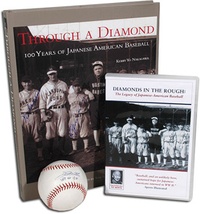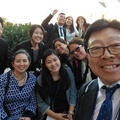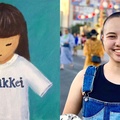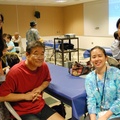Baseball, the quintessential American sport, has enjoyed immense popularity in Japan, as witnessed by the country’s recent championship at the inaugural World Baseball Classic. But did you know the role Japanese Americans played as early ambassadors of the sport?
The game in its modern form was invented by Alexander Cartwright in 1845. Although a pick-up style game had been played by children in North America from the mid 1700s, prior to Cartwright, there were no formalized rules of play. The game quickly spread from New York throughout the country. It was introduced in Japan in 1872 by an American schoolteacher. Young boys learned the sport and carried their passion for the game with them when they immigrated to America.
In Hawaii in the late 1800s, Japanese plantation workers played baseball to escape the tedium and harsh physical labor of the cane fields. As the rivalries between the plantation camp and company teams grew, so did the seriousness of the competitions.
On the mainland, Issei built baseball diamonds and formed their own teams. Artist Chiura Obata organized the first Issei baseball team in 1903 (his son Gyo Obata is a partner in HOK Sports which has built some of the world’s most beautiful baseball stadiums—Camden Yard, Jacob Field, Coors and ATT Park). They formed strong teams that often competed with non-Japanese teams. The Nisei grew up playing baseball, and when they came of age, they joined the Japanese American baseball teams that in time ranged from Mexico to Canada, and Hawaii to Nebraska. Many teams and all-star players traveled to Japan on goodwill tours. These visits strengthened the popularity of baseball in the country. Some stayed and joined Japanese professional teams.
The 1920s and 1930s were the golden age of Nisei baseball. Teams could be found in practically every community. Semipro teams were formed. The San Pedro Skippers, a Southern California semipro Nisei team averaged 14 runs a game in the late 1930s. Stars emerged and sometimes even were invited to play with professional teams. Shortstop George Aratani was invited to practice with the visiting Pittsburg Pirates in Santa Maria in the 1930s where his coaches were Hall of Famers Honus Wagner, Paul and Lloyd Waner. Kenso Nushida (nicknamed “Boy Wonder” in his native Hawaii) was the first Japanese American ballplayer to sign a AAA contract for the P.C.L. Sacramento Solons in 1932. Fumito Jimmy Horio, considered the Ty Cobb of the Nisei, won high praise from Babe Ruth and other Americans who competed against him in Japan in 1934. He would also play for the prewar Sioux Fall Canaries, Sacramento Solons and Tokyo Giants.
Even girls played baseball. Alice Hinaga and Asaye Sakamoto played in the famed Women’s Night Ball Association of San Jose. In 1938, 15-year-old Kazui “Babe” Oshiki toured Japan with the Max Factor all-girls softball team. One night in 1943, Oshiki was drafted to play with an all-male team at Soldier’s Field in Los Angeles. A crucial hit earned her the nickname “Babe.”
Although the bombing of Pearl Harbor brought sudden change to Japanese American communities, baseball continued to be played. Almost immediately after being sent to assembly centers, baseball started up again. It played a major role in establishing a sense of normalcy for the internees. Kenichi Zenimura (known as the “Dean of the Diamond”) and others quickly formed leagues and set up makeshift fields, uniforms, and equipment.
Baseball was played in all ten WRA camps but there were really four major Nisei camp teams. Manzanar had practically the entire roster of the San Fernando Aces. Gila River Arizona had a great team that was comprised of the powerhouse Guadalupe Y.M.B.A. team. Tule Lake and Jerome, Arkansas teams were also forces. Herb “Moon” Kurima (he got his nickname because his father used to make moonshine) managed and pitched for the Florin Athletic Club. On August 23, 1943, Kurima shut out Arkansas A&M 6-0 at the Jerome, Arkansas detention camp. In 1945, the Gila River Eagles baseball team beat a three-time state championship team from Tucson High School 11-10 in 10 innings. They broke their 52 game streak and scored 10 runs off their pitcher that had that had recorded a 0.00 E.R.A the previous year. These teams provided a much-needed lift in morale for the internees.
After the war, Japanese Americans returned to the communities. They started up their leagues again, but many of the of top players now had opportunities to play at higher levels in college and some even played professionally in Japan. Baseball again played a major role in bridging ties. At Lt. Cappy Harada’s suggestion, American baseball goodwill tours were organized. Lefty O’Doul, manager of the San Francisco Seals of the Pacific Coast League, played a ten-game series against American service teams and Japanese clubs. Harada arranged for O’Doul and Joe DiMaggio to conduct baseball clinics for the professional baseball clubs in Japan. He later organized additional tours of all-star major league players.
Japanese American players continued to do well in Japanese professional teams. Players like Tadashi “Bozo” Wakabayashi (the all-star pitcher for the Hanshin Tigers changed Japanese baseball with his aggressive style and became the first American inducted into the Japan Hall of Fame) who went to Japan before the war paved the way for their fellow Japanese Americans after the war. Dick Kitamura, the Zenimura brothers (Howard and Harvey were sons of Kenichi Zenimura), Ben Mitsuyoshi, Fibber Hirayama, and others played for various Japanese professional teams. The most notable however is Wally Yonamine. Yonamine was the first Japanese American to play professional football when he was drafted by the San Francisco 49ers. He played one season before an injury turned him towards baseball. He went to Japan and played for the Yomiuri Giants where he helped the Giants win three consecutive Japan Series championships from 1951-53. He finished his eleven year playing career with a .311 lifetime batting average before becoming a coach and manager for twenty-six years. He became the third Nisei to be inducted into the Japan Hall of Fame.
In the United States, it took much longer before a Japanese American made it to the Major League. Although many played for various minor league teams, on May 20, 1975, Ryan Kurosaki became the first Japanese American to play in the major leagues when he made his major league pitching debut as a St. Louis Cardinal where his teammates were Hall of Famers Bob Gibson and Lou Brock. He grew up in Hawaii and played for Kalani High School in Oahu. Ryan’s teammate in Hawaii was Lenn Sakata who would become the first Japanese American position player to play in the major leagues. Sakata played eleven seasons with the Milwaukee Brewers, Baltimore Orioles, Oakland A’s and the New York Yankees. He won a World Series ring with the Baltimore Orioles in 1983. Today he still manages a minor league team in San Jose.
Don Wakamatsu, the first Yonsei to play in the Major Leagues, played for the Chicago White Sox in 1991 and is today the bench coach for the Texas Rangers. Another Yonsei, Onan Masaoka, was a pitcher from Waiakea, Hawaii who played for the Dodgers in 1999 but is currently out of baseball.
Today, there are many baseball players from Japan playing for U.S. Major League teams. The first Japanese national to come was Masanori Murakami who was signed by Cappy Harada for the San Francisco Giants in 1963 and played for two years. Thirty years later, Hideo Nomo became the second when he joined the Los Angeles Dodgers. Nomo had an immediate impact, becoming Rookie of the Year, and along the way changed the way Americans saw Japanese players. He led the way for other Japanese players like Shigetoshi Hasegawa, Makoto Suzuki, Masato Yoshii, Hideki Irabu, Mac Suzuki, and most notably Ichiro Suzuki—the first all-star position player from Japan.
The contributions of Nisei baseball players have not been forgotten. Forty-nine prewar ballplayers were honored in a 1996 tribute at San Francisco’s Candlestick Park. The Nisei Baseball Research Project (NBRP) has honored pioneering players at Dodger Stadium (1997 and 2000), Oakland A's (1997), Arizona Diamondbacks (1997), and most recently, Wally Yonamine and Masanori Murakami in 2004 for the 150th anniversary of US/Japan relations.
The Diamonds in the Rough exhibition included significant venues such as the National Baseball Hall of Fame and Museum in 1998, Japan Hall of Fame in Tokyo in 1999, Japanese American National Museum in 2000, and the Morikami Museum in Florida in 2003. They are continuing to look for additional venues so that generations of baseball fans will learn about Japanese American baseball.
* * *
To learn more about Japanese American baseball, view multimedia clips, or find out the latest news, visit the Nisei Baseball Research Project’s website at www.niseibaseball.com.
* * *
* This article was originally published in the Japanese American National Museum Store online and written with the assistance of Kerry Yo Nakagawa. Many of the additional facts are from his book Through a Diamond: 100 Years of Japanese American Baseball.
© 2007 Japanese American National Museum







